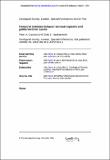Temporal relations between mineral deposits and global tectonic cycles
Abstract
Mineral deposits are heterogeneously distributed in both space and time, with variations reflecting tectonic setting, evolving environmental conditions, as in the atmosphere and hydrosphere, and secular changes in the Earth’s thermal history. The distribution of deposit types whose settings are tied to plate margin processes (e.g. orogenic gold, volcanic-hosted massive sulphide, Mississippi valley type Pb–Zn deposits) correlates well with the supercontinent cycle, whereas deposits related to intra-cratonic settings and mantle-driven igneous events, such as Ni–Cu–PGE deposits, lack a clear association. The episodic distribution of deposits tied to the supercontinent cycle is accentuated by selective preservation and biasing of rock units and events during supercontinent assembly, a process that encases the deposit within the assembled supercontinent and isolates it from subsequent removal and recycling at plate margins.
Citation
Cawood , P A & Hawkesworth , C 2013 , Temporal relations between mineral deposits and global tectonic cycles . in G R T Jenkin , P A J Lusty , I McDonald , M P Smith , A J Boyce & J J Wilkinson (eds) , Ore Deposits in an Evolving Earth . Geological Society Special Publications , vol. 393 , Geological Society , London . https://doi.org/10.1144/SP393.1
Publication
Ore Deposits in an Evolving Earth
ISSN
0305-8719Type
Book item
Description
Natural Environment Research Council (grant NE/J021822/1) supported this research.Collections
Items in the St Andrews Research Repository are protected by copyright, with all rights reserved, unless otherwise indicated.

